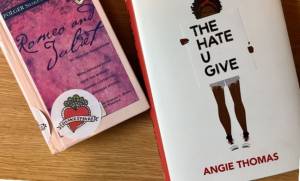 I teach high school English in St. Louis, Missouri, just miles from Ferguson, Missouri. Three years ago, after the Black Lives Matter movement started, I tried to bring the conversation about power and injustice into my classroom with the classics. Shakespeare raises tough, nuanced questions about identity, difference, community, and violence. His language is a good place to start.
I teach high school English in St. Louis, Missouri, just miles from Ferguson, Missouri. Three years ago, after the Black Lives Matter movement started, I tried to bring the conversation about power and injustice into my classroom with the classics. Shakespeare raises tough, nuanced questions about identity, difference, community, and violence. His language is a good place to start.
Then, earlier this year, I heard Angie Thomas’s novel The Hate U Give reviewed on NPR: it’s the perfect story to connect contemporary and classic literature.
For this paired-text lesson, we read 3.3 of Romeo and Juliet and pages 167-172 from The Hate U Give. The following essential questions framed the learning:
- What are the responsibilities of teenagers and adults in society? How do we know who is to blame for tragedy?
- How does a society of conflict influence a person’s decision making?
To start class, we first looked at Shakespeare’s prologue, and I asked my students: what happens when the setting of Romeo and Juliet changes? What “places” replace Verona? My students’ responses amazed me: YouTube, Facebook, Twitter, America and political stances, North Korea, St. Louis, Syria, our Cardinals Stadium when the Chicago Cubs are in town, our school rival, St. Louis. And my response?–If you say “Ferguson,” Shakespeare’s pattern doesn’t miss a beat.
Two households, both alike in dignity
In fair Verona where we lay our scene
from ancient grudge break to new mutiny
These lines speak volumes to our world. Romeo and Juliet is about the love and hate we give. And when characters ignore conflict, conflict only piles up for the star-crossed lovers. It might seem far-fetched, but I can’t help but wonder if Angie Thomas didn’t directly name her protagonist “Starr” as a shout out to Romeo and Juliet.
What’s even more amazing is how my students noticed that the riots in Verona aren’t the same as riots in our world today. Sometimes, they said, mutiny and riots are protests. Yes!
Next, after reading 3.3, students discussed this question in small groups:
- How does the Friar guide Romeo through this conflict? Evaluate his guidance.
After that, we watched a few minutes of this PBS video featuring an interview with Tupac Shakur. I like to remind my students that Shakespeare was an entertainer for his audiences in England. Many of the viewers of his plays wanted entertainment: they reveled in Shakespeare’s stories and language. Students regularly compare this bit of history to their own lives, and they point out the connections between Shakespeare and hip hop. Even Tupac himself referred to himself to be “like a tragic hero in a Shakespeare play.”
The title The Hate U Give suits Shakespeare’s star-crossed tragedy, doesn’t it? Some readers might notice that it is in fact borrowed from the first line of Tupac’s “Thug Life”—showing not only how texts talk to one another but also how literature helps us grapple with the big questions of life.
In class I let students ponder and discuss all of this, and then we turned to the contemporary novel.
Starr’s story opens with tragedy: her best friend is shot right in front of her by a white police officer in the dead of night. Starr is the sole witness, and she’s struggling with speaking out about the event. In an environment of sensitivity and respect, my students worked together to close-read the excerpt I shared with them, while keeping their Romeo and Juliet scene handy, too. In small groups they discussed these questions:
- How does Starr’s father guide Starr through conflict? Evaluate his guidance.
- How does the response the Friar gives to Romeo compare and contrast with the response Starr’s father give her? Which adult’s guidance is more valuable? Explain.
At the close of this lesson, once discussions ended, I asked students to write their observations, conclusions, and reflections. Below are some excerpts:
[Starr’s father] inspires Starr to think for herself. He makes her come up with her own conclusion. But Friar Lawrence…isn’t helping Romeo to think for himself. But he did, however, guide Romeo to see reality.” –John
“Starr’s Daddy’s [response is more valuable] because he tries to understand and tries to make Starr a better person, while Friar Lawrence just wants Romeo’s problems to go away.” –Ben
“Starr’s Dad is a stronger role model for teenagers. His premise is that you can’t judge someone’s struggle until you have walked a thousand miles in their shoes. The friar is irresponsible and hypocritical, marrying together Romeo and Juliet and then being upset with him for grieving over [losing] Juliet.” –Jordan

Comments
Wow! A powerful lesson to say the least. I don’t teach R&J but JC and Macbeth instead. Any ideas to bring contemporary texts with either one?
Julie Hogan — July 24, 2017